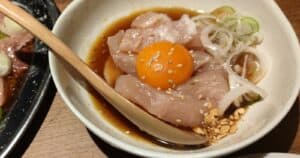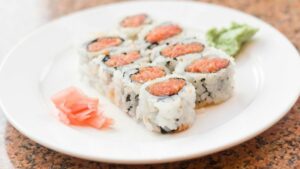“Is Japanese food overrated? This controversial question has sparked debates among food enthusiasts around the world. While some may argue that Japanese cuisine lacks flavor or comes with a hefty price tag, others appreciate the tradition, health benefits, and diverse range of dishes it offers.
In this blog post, we will delve deeper into these arguments and explore why Japanese cuisine truly deserves global acclaim. So, whether you’re a skeptic or a fan, keep reading to discover the untold stories behind this popular culinary tradition.
The Global Popularity of Japanese Cuisine
Japanese cuisine has become increasingly popular worldwide, thanks to its unique blend of traditional and modern elements. With a focus on seasonality, simplicity, and balance, Japanese dishes are visually stunning and delicious. Traditional ingredients like rice, fish, soy sauce, and seaweed are widely used in popular dishes such as sushi, tempura, ramen, and udon.
The global reputation of Japanese cuisine can be attributed to its rich flavors and the country’s deep respect for tradition and history, which extends beyond just its culinary heritage.
According to a study, Japanese cuisine ranks as the second most popular cuisine worldwide, just behind Italian cuisine. This speaks volumes about the global appeal and recognition of Japanese food. Its popularity can be witnessed in the ever-increasing number of Japanese restaurants opening across different countries.
People from diverse backgrounds are embracing Japanese cuisine, catering to a wide variety of palates and preferences.
One of the iconic dishes that has greatly contributed to the global popularity of Japanese cuisine is sushi. It consists of bite-sized portions of seasoned rice topped with fresh raw fish or seafood.
Sushi has gained a worldwide following due to its delicate flavors, artistic presentation, and interactive dining experience. It has become a staple in many countries, and its popularity continues to soar.
Apart from sushi, there are countless other Japanese dishes that have captured the hearts (and taste buds) of people worldwide. Tempura, which involves lightly battered and deep-fried seafood and vegetables, is another favorite. The crispy texture and subtle flavors of tempura have made it a sought-after dish in many parts of the world.
Ramen, a comforting noodle soup with various toppings and flavorful broth, has also gained global popularity. Its rich and complex flavors have made it a go-to comfort food for many.
Authenticity and Tradition in Japanese Food
Authenticity and tradition are critical aspects of Japanese cuisine, but they are also complex and subjective concepts that have evolved over time. Japanese food has always been adaptable, incorporating foreign ingredients and cooking techniques to create a unique blend of traditional and modern elements. While some traditional Japanese foods like tempura and ramen have non-Japanese origins, they have become integral to the country’s culinary identity.
The Japanese government has played a role in shaping the image of its national cuisine abroad, leading to debates about what constitutes “real” Japanese food. This desire for authenticity stems from the fact that it sells – Japanese restaurants abroad attract customers by offering an experience deemed authentic. However, authenticity is ultimately subjective and relies on people’s perceptions.
Japanese cuisine’s popularity worldwide can be attributed to its emphasis on seasonality, simplicity, and balance. The combination of conventional cooking approaches, attention to presentation, and cultural essence makes it an integral part of the global culinary landscape. Authenticity and tradition continue to be revered in Japanese food, but they have also evolved to embrace innovation and adaptation.
The Health Benefits of Japanese Diet
The Japanese diet is renowned for its numerous health benefits and is often recognized as one of the healthiest diets globally. This traditional diet is rich in nutrients and can help reduce the risk of chronic diseases such as type 2 diabetes and heart disease. Here are some of the key health benefits associated with the Japanese diet:
Reduced risk of chronic diseases: A typical Japanese diet consists of nutrient-rich foods like fish, seaweed, green tea, soy, fruits, and vegetables. It is low in added sugar, fat, and animal protein, which are factors that are believed to protect against heart disease.
Lower risk of certain cancers: Japan has a significantly lower risk for hormone-dependent cancers, like breast and prostate cancers. The abundance of vegetables in the Japanese diet provides essential minerals that support overall nutrition and may help reduce the likelihood of developing these cancers.
Improved heart health: The Japanese diet is low in fat and has high levels of omega-3 fatty acids, which are known for their heart-healthy benefits. Fish, a staple in the Japanese diet, is an excellent source of omega-3 fatty acids, helping to lower the risk of heart problems.
Better digestion: The Japanese diet is fiber-rich, thanks to the inclusion of vegetables, soy foods, legumes, and soups. This abundance of fiber can help promote good digestion, reduce appetite, and increase feelings of fullness, aiding in weight control.
Nutrient-rich: The Japanese diet naturally provides a wide range of minerals and nutrients, including fiber, calcium, potassium, iron, magnesium, vitamins A, C, and E. This balanced combination of foods not only helps with satiety but also supports a healthy metabolism.
Varied and Unique Flavors in Japanese Cuisine
Japanese cuisine offers a delightful array of unique and varied flavors that cater to different palates and preferences. Whether you’re a fan of bold umami or prefer sweeter tastes, Japanese culinary traditions have something for everyone. Let’s delve deeper into the rich tapestry of flavors found in Japanese cuisine.
Intrinsic Flavor Emphasis:
Japanese cuisine places great emphasis on the natural flavors of the ingredients. Traditional dishes like okonomiyaki, tempura, and various noodles highlight the familiar ingredients while showcasing their true taste. Furthermore, the use of seasonal and local ingredients not only enhances the flavors but also promotes sustainability in the food industry.
Artistic Presentation:
When it comes to presentation, Japanese cuisine is unparalleled. Dishes are not only a treat for the taste buds but also a feast for the eyes. The artistic and aesthetically pleasing presentation of Japanese food adds an extra layer of enjoyment to the dining experience.
Flavors to Discover:
One of the wonders of Japanese cuisine is its diverse range of flavors. From sweet to salty and from sour to the renowned umami, your taste buds will embark on an exciting journey. Umami, the fifth taste, is often described as a savory, meaty, or “mouthwatering” flavor. Its presence in dishes elevates the overall taste experience and is a hallmark of Japanese cuisine.
Unique Ingredients:
Japanese cuisine introduces unique ingredients that offer distinct and unforgettable flavors. Miso, a fermented soybean paste packed with umami, is an essential and versatile ingredient used in various dishes. Moreover, the delicate flavor of sakura, derived from cherry blossoms, adds a touch of elegance to desserts and even tea. Sakura-infused sweets and sakurayu, a slightly salty cherry blossom tea, are delightful examples of this unique flavor.
Japanese cuisine is truly a treasure trove of flavors. From well-known dishes to local specialties, it offers a remarkable choice for food enthusiasts seeking a distinctive culinary experience. So, next time you dine Japanese, prepare your taste buds for an adventure into the world of delightful and varied flavors that will undoubtedly satisfy your palate.
Impeccable Quality of Japanese Ingredients
Japan is renowned for its impeccable quality of ingredients, which play a crucial role in enhancing the flavors of its iconic dishes. The Japanese diet is naturally rich in fish, seaweed, green tea, soy, fruits, and vegetables. These ingredients are low in added sugar, fat, and animal protein, making them beneficial for heart health. The quality of Japanese ingredients is not just a marketing ploy but has become an inherent component of many Japanese products.
The Japanese government’s efforts to control the image of its national cuisine overseas have sparked debates about what qualifies as “authentic” Japanese food. However, there is no denying the significance of staple ingredients in Japanese cooking. Shoyu (soy sauce), miso paste, instant dashi, mirin, nori, udon noodles, and okonomiyaki flour are essential pantry items that contribute to the unique flavors of Japanese dishes and meals.
Japanese cuisine is also praised for its fiber-rich components. Fiber is crucial for good digestion and can be found in abundance in the Japanese diet. The incorporation of fiber-rich vegetables, soy foods, legumes, and soups in traditional Japanese meals may help reduce appetite and promote weight control.
The popularity of Japanese dishes like sushi, tempura, ramen, and udon on a global scale further attests to the impeccable quality of Japanese ingredients. Staples like rice, fish, soy sauce, and seaweed are widely used, and their flavors and textures have captivated palates worldwide. Japanese cuisine’s meticulous attention to ingredients has contributed to its reputation for exceptional quality and taste.
Japanese Food and Cultural Symbolism
Japanese food is not only a culinary experience but also a reflection of cultural symbolism and traditional beliefs. Its preparation and consumption are deeply rooted in Japanese customs and values. Here are some key insights into the cultural significance of Japanese cuisine:
- Spiritual Significance: In Shintoism, a native Japanese religion, food holds spiritual symbolism. Food offerings, known as shinsen, are presented to deities as a gesture of respect and gratitude towards nature, emphasizing the deep connection between the Japanese people and their surroundings.
- Aesthetic Values: The Japanese term for their cuisine, sappari, reflects an aesthetic rooted in cleanliness, harmony, and simplicity. It is characterized by lightness and honesty, embodying the Japanese way of life. This aesthetic essence is one of the defining aspects of Japanese culture.
- Seasonal Traditions: Japanese cuisine highlights the importance of using seasonal ingredients. Special dishes are prepared during seasonal events and celebrations, incorporating ingredients that are in season. These dishes are not only delicious but also convey wishes for happiness, health, and prosperity for families.
- Evolving Adaptations: Despite its deep-rooted traditions, Japanese cuisine has always been open to incorporating foreign influences. For example, the popularity of curry in Japan showcases how cultural exchange has influenced and enriched Japanese cuisine. It reflects the ability of Japanese food to adapt to changing times, incorporating new ingredients and cooking techniques while maintaining its core values.
The Japanese Food Experience: From Street Food to Fine Dining
Japan offers a diverse range of culinary experiences, from affordable street food to high-end fine dining. Here are some key aspects of the Japanese food experience:
- Street Food: Japanese street food is renowned for its delicious flavors and variety. From mouthwatering takoyaki (grilled octopus dumplings) to yakitori (grilled chicken skewers) and okonomiyaki (savory pancakes), street food provides an affordable and authentic way to indulge in local delights.
- Casual Dining: Izakayas and tachinomiyas are popular casual dining options in Japan. Izakayas are cozy pubs that serve a wide range of small plates and snacks, while tachinomiyas are standing bars that offer drinks and appetizers. These casual establishments offer a relaxed atmosphere to enjoy tasty food and drinks with friends.
- Fine Dining: Japan is home to world-class fine dining establishments, providing unforgettable culinary experiences. Kaiseki cuisine, a multi-course meal that focuses on seasonal ingredients, is often served in traditional settings. While fine dining in Japan can be expensive, it is well worth it for the exceptional taste and presentation of the dishes.
Sushi is an integral part of Japanese cuisine and can be enjoyed from street vendors to high-end restaurants. Made with vinegared rice and fresh seafood, sushi is typically accompanied by wasabi, soy sauce, and pickled ginger. It is a must-try for all visitors to Japan.
Fish markets in Japan are a paradise for seafood lovers. The Toyosu Market in Tokyo and Hakodate Morning Market in Hokkaido offer a wide range of fresh seafood. Visitors can savor sushi or kaisen-don, a bowl of raw fish over rice, made with the best and freshest ingredients available.
Furthermore, each region in Japan has its own culinary specialties. For example, Kyoto’s Nishiki Market offers unique and wonderful foods that are part of Kyoto cuisine. Osaka’s Wanaka Honten is known for its local specialties like tako-yaki (grilled octopus dumplings) and tako-sen (two dumplings sandwiched between sembei rice crackers). Exploring regional dishes adds depth and diversity to the Japanese food experience.





